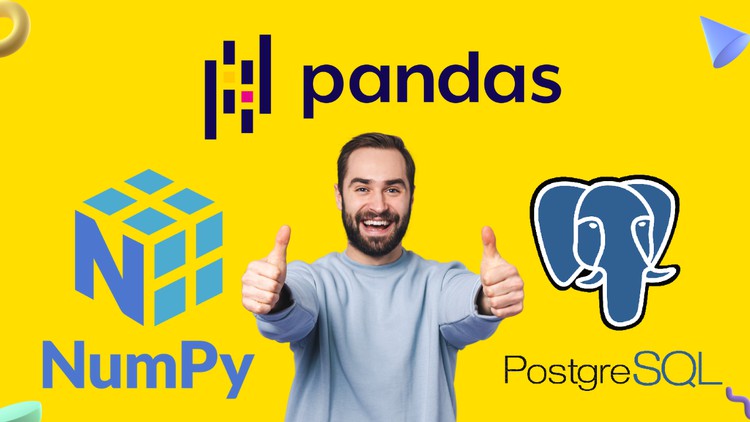
NumPy – Pandas – PostgreSQL for beginners and professionals.
What you will learn
Basics of Numpy, Arrays, Lists.
Basic Mathematics (arithmetic, trigonometry, etc.)
Advanced Indexing and Boolean Masking
Data analysis using python
Data cleaning
Correlations
Description
Welcome! This is Numpy,Pandas and PostgreSQL for Beginners course.
One question or concern I get a lot is that people want to learn deep learning and data science, so they take these courses, but they get left behind because they don’t know enough about the Numpy stack in order to turn those concepts into code.
Even if I write the code in full, if you don’t know Numpy, then it’s still very hard to read.
This course is designed to remove that obstacle – to show you how to do things in the Numpy stack that are frequently needed in deep learning and data science.
So what are those things?
Numpy. This forms the basis for everything else. The central object in Numpy is the Numpy array, on which you can do various operations.
- The key is that a Numpy array isn’t just a regular array you’d see in a language like Java or C++, but instead is like a mathematical object like a vector or a matrix.
- That means you can do vector and matrix operations like addition, subtraction, and multiplication.
- The most important aspect of Numpy arrays is that they are optimized for speed. So we’re going to do a demo where I prove to you that using a Numpy vectorized operation is faster than using a Python list.
- Then we’ll look at some more complicated matrix operations, like products, inverses, determinants, and solving linear systems.
Welcome to the most comprehensive Pandas course available on Udemy! An excellent choice for both beginners and experts looking to expand their knowledge on one of the most popular Python libraries in the world!
Pandas for Data Analysis in Python offers in-depth video tutorials on the most powerful data analysis toolkit
Why learn pandas?
If you’ve spent time in a spreadsheet software like MS Excel or Google Sheets and want to take your data analysis skills to the next level, this course is for you!
Pandas is a Python package providing fast, flexible, and expressive data structures designed to make working with “relational” or “labeled” data both easy and intuitive. It aims to be the fundamental high-level building block for doing practical, real-world data analysis in Python.
Pandas is the most powerful and flexible open source data analysis/manipulation tool available in any language.
pandas is well suited for many different kinds of data:
- Tabular data with heterogeneously-typed columns, as in an SQL table or Excel spreadsheet
- Ordered and unordered (not necessarily fixed-frequency) time series data.
- Arbitrary matrix data (homogeneously typed or heterogeneous) with row and column labels
- Any other form of observational / statistical data sets. The data need not be labeled at all to be placed into a pandas data structure
Data Analysis with Pandas and Python is bundled with dozens of datasets for you to use. Dive right in and follow along with my lessons to see how easy it is to get started with pandas!
If you want to learn how to gain insights from data but are too intimidated by databases to know where to start, then this course is for you. This course is a gentle but comprehensive introduction to MySQL, one of the most highly in-demand skills in the business sector today.
Help you understand and apply PostgreSQL , including Database Design and Data Analysis.
Having database skills is absolutely vital for developers to avoid getting left behind and to maximize job and consulting opportunities.
- Key concepts you will learn and work on within this course.
- SQL (Structured Query Language – very much an in-demand technology).
- PostgreSQL (one of the world’s most popular and widely used databases).
- Database Design
- Data Analysis
Content of the course.
Creating, Modifying, and Deleting Tables in a Database
Inserting, Updating, and Deleting Data from Tables
Select Queries
Aggregate Functions
Creating Databases.
Who this course is for:
- Anyone interested in learning PostgreSQL to help with their current job or to find a new role. PostgreSQL is one of today’s most in-demand skills
- Anyone looking to answer complex business problems and generate reports using data
- Business owners, people in sales, or people in marketing roles who are interested in understanding company data better.
- Developers who are looking to build applications (e.g. social network, e-commerce site) using PostgreSQL
Your new job or consulting opportunity awaits!
Why not get started today?
Content
